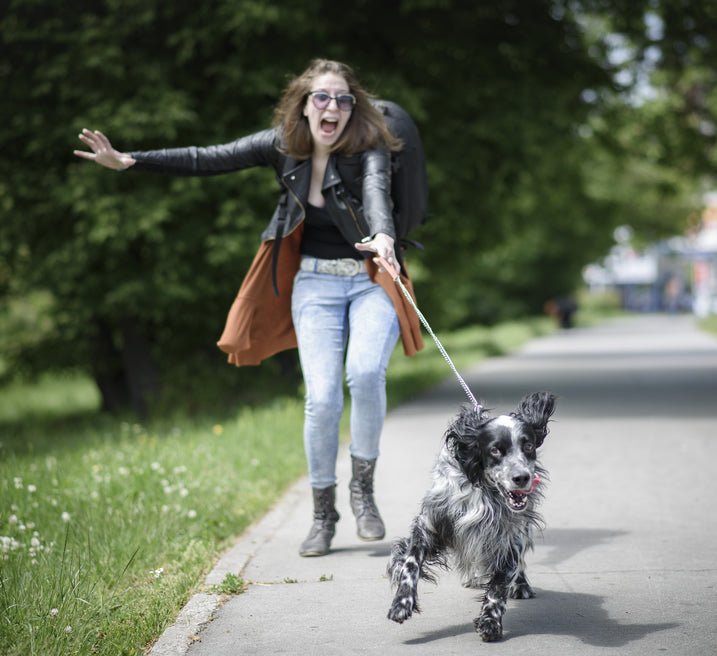![]() Listen to the Podcast
Listen to the Podcast
Do you have a dog who loses their mind around other dogs? Does your dog turn into a champion weight puller the second they see another dog? Well, if you're ready to put in some work, here's how to turn Fido into a polite and enjoyable partner to walk with, regardless of the distractions.
Teach It
This is the key to all success in dog training. Don't just HOPE for a dog with better manners - make it happen! A little time and the right information will go a long way towards your success.
First, take some time away from the distraction of other dogs, squirrels and fence posts to sniff and .... well, you know. When teaching anything new, it's crucial that the environment is conducive to learning. That means starting with as little distraction as possible. Expecting dogs to learn leash manners in the face of distraction is equivalent to trying to learn math while riding a roller coaster - It's not likely to happen as there is far too much excitement to learn anything successfully. Set your dog up for success by controlling your environment during the teaching phase. Once they have a solid understanding of the skills you're teaching, start to add distractions slowly, but keep the reinforcement level high. Create your own distractions so that you have complete control over what your dog is facing and when. Bowls of food or toys on the ground are usually tempting for most dogs. Always start small and build on your dog's success. When they can handle stationary distractions, start to add in some moving ones, like people or kids.
Don't take the power of repetition for granted. The more you work on it, the better your dog's understanding will be. If you expect to have a dog who can politely pass other dogs and distractions on the street, you need to put in the time and effort to teach them how.
Rehearse What You Want
This is a big one. There's a saying that goes, "practice makes perfect," but we know better! Only "perfect practice makes perfect!" Rehearsal is a huge factor in any dog's behaviour. If you head out for a walk and allow your dog to pull towards every dog they see, that will become their default behaviour. In addition, they'll start to feel frustration build over wanting to get there, but being restrained. You will likely see their leash manners get worse and in some cases, they could even develop on-leash aggression.
When walking in the presence of other dogs, or any distraction for that matter, our goal is to have our dogs assume the distraction is off limits until they get permission to investigate. Since what your dog rehearses is what will become habit, keep that in mind as you see other dogs on walks - even friendly dogs who you may want your dog to be able to interact with. Take your time and make sure they receive permission from you to say hello first!
Ditch the Retractable Leash
Extendible leashes have their place, but are detrimental to a young dog still in training. Please check out our previous post on these leashes if you're thinking of using one. They allow too much freedom and the constant tension on the collar gives dogs the confusing message that pulling is allowed. Until they are trained and have reliable verbal control, use a solid state leash about 6 feet in length for walks and training.
Engage with Your Dog
When distractions are present, engage with your dog. While you may walk quietly and peacefully in some situations, when a distraction appears, help your dog! Ask them to focus on you as you pass the temptation - don't just hold your breath. Make it happen and reward them with something very high value. The more your dog rehearses wonderful things coming from you, the more they'll learn to ignore distractions out in the real world. If you are in a stationary position, rather than walking, like at the vet clinic, work on tricks or obedience skills. Remember that dogs do what's rewarding! If you're rewarding to them, they won't look elsewhere for entertainment and when they do, they'll return to you quickly.
As always, Happy Training!
|
|
Hi! I'm Shannon and I joined the McCann team in 1999 while training Quincey, my wonderful and spirited Rottweiler, to have good listening skills. I'm the Director of Online Training and Content for McCann Professional Dog Trainers and I enjoy writing about dogs and dog training for the McCann blog. I currently share my life with 2 Tollers (Reggie & Ned) and I love helping people develop the best possible relationship with their 4-legged family members. |


